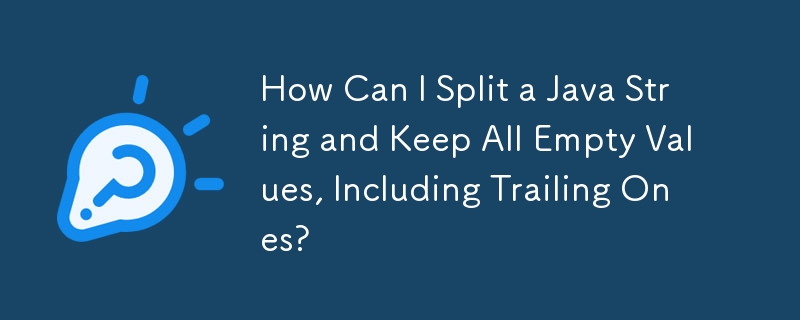 Java
Java
 javaTutorial
javaTutorial
 How Can I Split a Java String and Keep All Empty Values, Including Trailing Ones?
How Can I Split a Java String and Keep All Empty Values, Including Trailing Ones?
How Can I Split a Java String and Keep All Empty Values, Including Trailing Ones?

Splitting Java Strings Without Removing Empty Values
When attempting to split a Java string using the split(String regex) method, one might expect to retain empty values in the resulting array, particularly if they fall anywhere within the string. However, by default, the split method removes trailing empty values from the output array.
Consider the following code:
String data = "5|6|7||8|9||";
String[] split = data.split("\|");
System.out.println(split.length);In this example, we expect to obtain eight values in the split array, including empty strings: [5, 6, 7, EMPTY, 8, 9, EMPTY, EMPTY]. However, we unexpectedly end up with only six values due to the automatic removal of trailing empty strings.
To resolve this issue, we can leverage the overloaded split(String regex, int limit) method, where limit is set to a negative value. This instructs the method to refrain from removing trailing empty strings.
String[] split = data.split("\|", -1);By invoking the overloaded version, we override the default behavior and preserve all empty values in the split array, regardless of their position.
Additional Insights
It's important to note that the default behavior of removing trailing empty strings only applies when those empty strings are generated as a result of the splitting process. This means that if an empty string exists within the original input string (e.g., "".split(anything)), it will remain in the resulting array because it was not introduced by the splitting mechanism.
This granular understanding of the split method's behavior ensures that developers have greater control over the content of their output arrays when dealing with potentially empty values.
The above is the detailed content of How Can I Split a Java String and Keep All Empty Values, Including Trailing Ones?. For more information, please follow other related articles on the PHP Chinese website!

Hot AI Tools

Undresser.AI Undress
AI-powered app for creating realistic nude photos

AI Clothes Remover
Online AI tool for removing clothes from photos.

Undress AI Tool
Undress images for free

Clothoff.io
AI clothes remover

AI Hentai Generator
Generate AI Hentai for free.

Hot Article

Hot Tools

Notepad++7.3.1
Easy-to-use and free code editor

SublimeText3 Chinese version
Chinese version, very easy to use

Zend Studio 13.0.1
Powerful PHP integrated development environment

Dreamweaver CS6
Visual web development tools

SublimeText3 Mac version
God-level code editing software (SublimeText3)

Hot Topics
 1377
1377
 52
52
 How does Java's classloading mechanism work, including different classloaders and their delegation models?
Mar 17, 2025 pm 05:35 PM
How does Java's classloading mechanism work, including different classloaders and their delegation models?
Mar 17, 2025 pm 05:35 PM
Java's classloading involves loading, linking, and initializing classes using a hierarchical system with Bootstrap, Extension, and Application classloaders. The parent delegation model ensures core classes are loaded first, affecting custom class loa
 How do I implement multi-level caching in Java applications using libraries like Caffeine or Guava Cache?
Mar 17, 2025 pm 05:44 PM
How do I implement multi-level caching in Java applications using libraries like Caffeine or Guava Cache?
Mar 17, 2025 pm 05:44 PM
The article discusses implementing multi-level caching in Java using Caffeine and Guava Cache to enhance application performance. It covers setup, integration, and performance benefits, along with configuration and eviction policy management best pra
 How can I use JPA (Java Persistence API) for object-relational mapping with advanced features like caching and lazy loading?
Mar 17, 2025 pm 05:43 PM
How can I use JPA (Java Persistence API) for object-relational mapping with advanced features like caching and lazy loading?
Mar 17, 2025 pm 05:43 PM
The article discusses using JPA for object-relational mapping with advanced features like caching and lazy loading. It covers setup, entity mapping, and best practices for optimizing performance while highlighting potential pitfalls.[159 characters]
 How do I use Maven or Gradle for advanced Java project management, build automation, and dependency resolution?
Mar 17, 2025 pm 05:46 PM
How do I use Maven or Gradle for advanced Java project management, build automation, and dependency resolution?
Mar 17, 2025 pm 05:46 PM
The article discusses using Maven and Gradle for Java project management, build automation, and dependency resolution, comparing their approaches and optimization strategies.
 How do I create and use custom Java libraries (JAR files) with proper versioning and dependency management?
Mar 17, 2025 pm 05:45 PM
How do I create and use custom Java libraries (JAR files) with proper versioning and dependency management?
Mar 17, 2025 pm 05:45 PM
The article discusses creating and using custom Java libraries (JAR files) with proper versioning and dependency management, using tools like Maven and Gradle.



